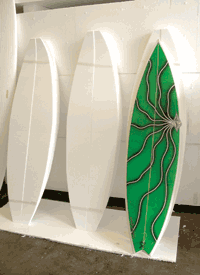
Polystyrene is a polymer made from the monomer styrene, a liquid hydrocarbon
that is commercially manufactured from petroleum by the chemical industry.
At room temperature, polystyrene is normally a solid thermoplastic, but can
be melted at higher temperature for molding or extrusion, then resolidified.
Styrene is an aromatic monomer, and polystyrene is an aromatic polymer.
Polystyrene was accidentally discovered in 1839 by Eduard Simon an
apothecary in Berlin, Germany. From storax, the resin of Liquidambar
orientalis, he distilled an oily substance, a monomer which he named styrol.
Several days later Simon found that the styrol had thickened, presumably
due to oxidation, into a jelly he dubbed styrol oxide ("Styroloxyd").
By 1845, English chemist John Blyth and German chemist August Wilhelm von Hofmann
showed that the same transformation of styrol took place in the absence of oxygen.
They called their substance metastyrol. Analysis later showed that it was chemically
identical to Styroloxyd. In 1866 Marcelin Berthelot correctly identified the formation
of metastyrol from styrol as a polymerization process. About 80 years went by before
it was realized that heating of styrol starts a chain reaction which produces
macromolecules, following the thesis of German organic chemist Hermann
Staudinger (1881 - 1965).
This eventually led to the substance receiving its present name, polystyrene. The I.G. Farben company began manufacturing polystyrene in Ludwigshafen, Germany, about 1931, hoping it would be a suitable replacement for die cast zinc in many applications. Success was achieved when they developed a reactor vessel that extruded polystyrene through a heated tube and cutter, producing polystyrene in pellet form.
Pure solid polystyrene is a colorless, hard plastic with limited flexibility. It can be
cast into molds with fine detail. Polystyrene can be transparent or can be made
to take on various colors. It is economical and is used for producing plastic model
assembly kits, plastic cutlery, CD "jewel" cases, and many other objects where a
fairly rigid, economical plastic of any of various colors is desired.
Polystyrene's most common use, however, is as expanded polystyrene (EPS).
Expanded polystyrene is produced from a mixture of about 90-95% polystyrene
and 5-10% gaseous blowing agent, most commonly Pentane or carbon dioxide.
The solid plastic is expanded into a foam through the use of heat, usually steam.
Extruded polystyrene (XPS), which is different from expanded polystyrene (EPS),
is commonly known by the trade name Styrofoam.
The voids filled with trapped air give it low thermal conductivity. This makes it ideal as a construction material and it is therefore sometimes used in structural insulated panel building systems. It is also used as insulation in building structures, as molded packing material for
cushioning fragile equipment inside boxes, as packing "peanuts", as non-weight-bearing
architectural structures (such as pillars), and also in crafts and model building,
particularly architectural models. Foamed between two sheets of paper, it makes
a more-uniform substitute for corrugated cardboard, tradenamed Fome-Cor. A
more unexpected use for the material if as a lightweight fill for embankments
in the civil engineering industry.

Expanded polystyrene used to contain CFCs, but other, more environmentally-safe
blowing agents are now used. Because it is an aromatic hydrocarbon, it burns with
an orange-yellow flame, giving off soot, as opposed to non-aromatic hydrocarbon
polymers such as polyethylene, which burn with a light yellow flame.
Production methods include sheet stamping (PS) and injection molding (both PS and HIPS).
The chemical makeup of polystyrene is a long chain hydrocarbon with every other carbon
connected to a Phenyl group (an aromatic ring similar to benzene).
EPS foam can be molded into different shapes -
1. EPS blocks are usually 4' x 3' x 8' or 4' x 4' x 8'

2. EPS shapes (molded)

3. EPS Surfboards

Cutting EPS foam
Expanded polystyrene is very easily cut with a hot-wire foam cutter, which is easily made
by a heated and taut length of wire, usually nichrome due to nichrome's resistance to
oxidation at high temperatures and its suitable electrical conductivity. The hot wire
foam cutter works by heating the wire to the point where it can vaporize foam immediately
adjacent to it. The foam gets vaporized before actually touching the heated wire,
which yields exceptionally smooth cuts.
Polystyrene, shaped and cut with hot wire foam cutters, is used in architecture models,
signs, props for amusement parks, movie sets, airplane construction, and much more.
Such cutters may cost just a few dollars (for a completely manual cutter) to tens of
thousands of dollars for large CNC machines that can be used in high-volume industrial production.
Polystyrene can also be cut with a traditional cutter. In order to do this without ruining
the sides of the blade one must first dip the blade in water and cut with the blade at
an angle of about 30º. The procedure has to be repeated multiple times for best results.
Polystyrene can also be cut on 3 and 5-axis CNC routers, enabling large-scale
prototyping and model-making. Special polystyrene cutters are available that
look more like large cylindrical rasps
